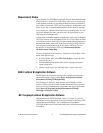
© National Instruments Corporation 13 NI USB-9229/9239 User Guide and Specifications
Passband
The signals within the passband have frequency-dependent gain or
attenuation. The small amount of variation in gain with respect to
frequency is called the passband flatness. The digital filters of the
NI USB-9229/9239 adjust the frequency range of the passband to match
the data rate. Therefore, the amount of gain or attenuation at a given
frequency depends on the data rate. Figure 11 shows typical passband
flatness for the 50 kS/s data rate.
Figure 11. Typical Passband Response
Stopband
The filter significantly attenuates all signals above the stopband frequency.
The primary goal of the filter is to prevent aliasing. Therefore, the stopband
frequency scales precisely with the data rate. The stopband rejection is the
minimum amount of attenuation applied by the filter to all signals with
frequencies within the stopband.
Alias-Free Bandwidth
Any signal that appears in the alias-free bandwidth of the
NI USB-9229/9239 is not an aliased artifact of signals at a higher
frequency. The alias-free bandwidth is defined by the ability of the filter to
reject frequencies above the stopband frequency and equals the data rate
minus the stopband frequency.
Frequency (kHz)
2520
0.025
0.000
–0.025
–0.050
151050
Gain (dB)


















